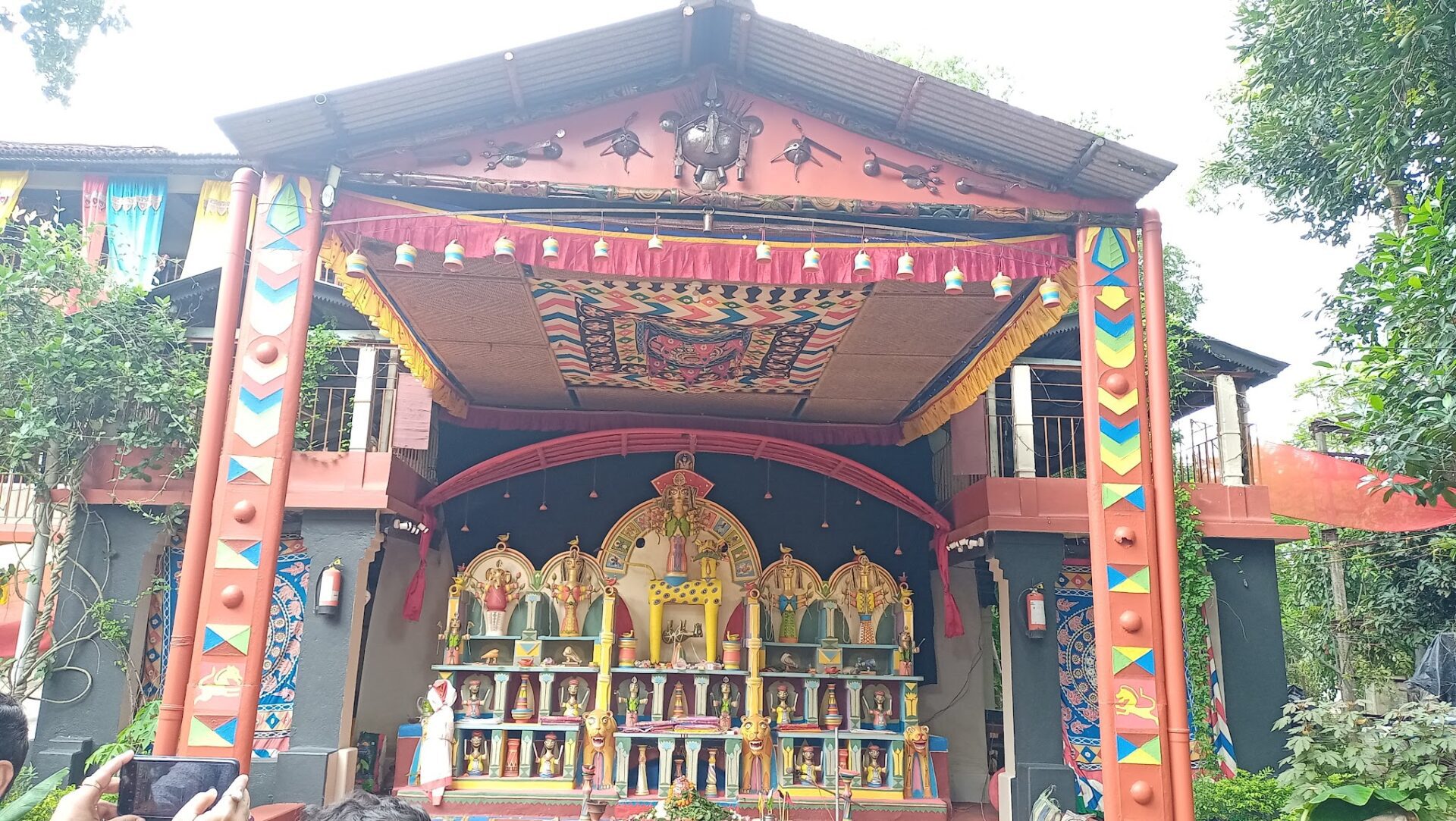How Santiniketan’s Cultural Significance Compares to Others: A Unique Institution Beyond Conventional Universities
Santiniketan, founded by the visionary Rabindranath Tagore, is unlike any other university in the world. Situated in the rural heart of West Bengal, India, it stands as a beacon of cultural convergence, blending diverse languages, traditions, and philosophies into a singular educational experience. Tagore’s vision for Santiniketan was not just about education—it was about creating a living, breathing experiment in rural revival, eco-friendliness, and internationalism.
Tagore’s Vision: A Departure from Western University Models
Rabindranath Tagore was clear in his stance that Santiniketan was fundamentally different from the Western concept of a university. As he famously stated, “The moment we conceive of a university, we are beset by the idea of a Cambridge university, an Oxford university, and numerous other European universities, which take up all the space in our minds.” For Tagore, these institutions were deeply rooted in their own cultural contexts—organic extensions of European life.
He argued that the Western approach of picking and choosing the “best aspects” of each university to create a perfect model was fundamentally flawed. Tagore compared this to modern medicine, where fragments of skin might replace missing parts but could never construct a whole, living person from disjointed pieces. To Tagore, a university needed to be an original, living entity, not a patchwork of borrowed ideas.
A Living Experiment in Rural Revival and Eco-Friendliness
Santiniketan goes beyond the traditional boundaries of academic learning by embracing nature and rural life. Tagore’s principles emphasized a harmonious relationship between humanity and the environment—a concept that resonates even more today as the world grapples with environmental degradation. The institution’s commitment to eco-friendliness and sustainable living sets it apart from its Western counterparts, many of which were designed with urban settings and industrialized contexts in mind.
A Cultural Convergence and Amalgamation of Traditions
One of the most defining features of Santiniketan is its embodiment of diverse cultures and languages. Unlike typical universities that often reflect a singular national or cultural identity, Santiniketan was designed as a melting pot where the East met the West, and where art, literature, music, and education intertwined. This cultural amalgamation goes beyond surface-level diversity—it is an immersive experience that shapes the worldview of its students.
The Realization of Tagore’s Principles of Internationalism and Universality
Tagore envisioned Santiniketan as a space that transcended national boundaries, promoting the ideals of internationalism and universality long before these became popular themes in global education. His approach was not just about learning from other cultures but integrating them into the everyday life of the institution. This inclusiveness made Santiniketan a pioneer in promoting global understanding through education.
Santiniketan and the Bauhaus School in Weimar, Germany: A Comparative Look
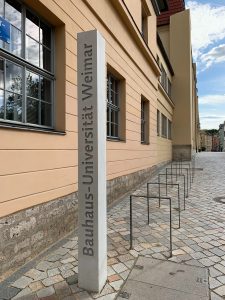
Bauhaus School in Weimar, Germany
The Bauhaus School, founded in 1919 by the visionary architect Walter Gropius in Weimar, Germany, represents a turning point in the history of modern design. Weimar, already a revered cultural center in Europe, gained further recognition when it was designated a UNESCO World Heritage site in 1998, underscoring the profound influence of the Bauhaus on the global arts landscape.
The Bauhaus School was an innovative fusion of craftsmanship and fine arts, striving to create a comprehensive work of art that encompassed architecture and various other art forms. Unlike traditional educational models in industrial arts, fine arts, and architecture, Bauhaus introduced a groundbreaking curriculum based on progressive teaching methods. Its approach was deeply rooted in socialist ideology, promoting the belief that artists have a social responsibility towards their community, and that art should serve the needs of society.
Bauhaus’s influence extended far beyond Weimar, revolutionizing fields such as art, graphic design, typography, interior design, industrial design, and architecture. The movement left an indelible mark on modernist design principles, impacting Western Europe, the United States, Canada, and Israel. The school’s avant-garde philosophies encouraged a minimalist, functional style that continues to shape the aesthetics of contemporary design.
Legacy of Bauhaus in Modern Education
Today, the Bauhaus University of Weimar upholds this legacy through its diverse faculties, including Architecture, Art and Design, Civil Engineering, and Media. Renowned for its innovative courses, the university offers programs in civil engineering, architecture, free art, design, web design, visual communication, media design, media culture, and more. The institution’s emphasis on interdisciplinary learning and experimental approaches echoes the Bauhaus spirit of breaking boundaries between art and technology.
Santiniketan: A Parallel Vision in the East
Santiniketan, founded by the Nobel laureate Rabindranath Tagore in the early 20th century in West Bengal, India, mirrors some of the progressive ideals seen in the Bauhaus School. While the two institutions were separated by geography and cultural context, they shared a common goal: to redefine education by integrating art, culture, and community service.
Tagore’s vision for Santiniketan was deeply intertwined with Indian traditions, emphasizing a holistic approach to learning that blended art, music, literature, and nature. Much like Bauhaus, Santiniketan aimed to break down the rigid barriers of conventional education, fostering creativity, critical thinking, and a sense of social responsibility among its students.
Santiniketan’s focus was not just on academics but also on nurturing the individual spirit, promoting the idea that education should be a harmonious blend of intellectual, artistic, and moral development. This philosophy created a space where art was not just learned but lived—a concept that resonates with Bauhaus’s approach to making art an integral part of everyday life.
Connecting Ideals: Santiniketan and Bauhaus
Both Santiniketan and the Bauhaus School were revolutionary in their respective fields, challenging traditional modes of education and creating environments where art and community were inseparably linked. While Bauhaus shaped modernist architecture and design on a global scale, Santiniketan became a beacon for cultural and educational reform in India.
Despite their different mediums—Bauhaus with its focus on industrial design and architecture, and Santiniketan with its emphasis on the arts and humanities—both institutions continue to inspire educational models worldwide. They remind us that art and creativity, when placed at the heart of learning, have the power to transform societies.
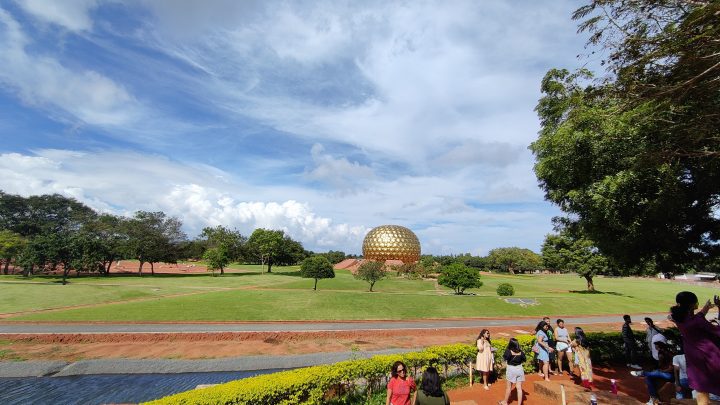
Santiniketan Compared to Auroville: Two Visionary Settlements of India
Santiniketan and Auroville are two of India’s most remarkable cultural and spiritual experiments, each representing the vision of a great Indian thinker. Santiniketan, shaped by Rabindranath Tagore, and Auroville, inspired by the teachings of Sri Aurobindo and The Mother, stand as testaments to the ideals of human unity, cultural integration, and a harmonious relationship with nature. Despite their distinct origins and focuses, both places share a commitment to creating communities that transcend conventional boundaries.
Auroville: A City of the Future Rooted in Unity
Located on the Coromandel Coast in southern India, just outside Pondicherry, Auroville was founded in 1968 as an experimental township dedicated to the principles of human unity and sustainable living. Envisioned by Sri Aurobindo and Mirra Alfassa (The Mother), Auroville began as a barren expanse of land that has since transformed into a thriving, green oasis filled with diverse flora and fauna. It is an ongoing experiment in community living, aiming to accommodate up to 50,000 people from all over the world.
The Vision Behind Auroville: A City for Human Unity
Auroville’s founding principle is to manifest human unity amidst diversity, blending Eastern and Western philosophies to create a universal township where people of all nationalities, creeds, and backgrounds can coexist peacefully. This city-in-the-making is home to about 20,000 residents and shares its space with a local population of 35,000. The residents engage in various activities that strengthen the bond between humans and nature, such as organic farming, environmental conservation, education, and community development projects.
Auroville’s holistic approach to living is reflected in its Master Plan, which aims to integrate urban and rural development in a way that benefits both. Through innovative planning and sustainable practices, Auroville seeks to inspire other cities worldwide by demonstrating how human settlements can grow in harmony with nature.
Santiniketan: Tagore’s Vision of Education and Cultural Synthesis
While Auroville is focused on community living and ecological sustainability, Santiniketan, founded by Rabindranath Tagore, places a strong emphasis on education, culture, and artistic expression. Located in West Bengal, Santiniketan began as an ashram and later developed into Visva Bharati University, an institution that played a critical role in shaping modern Indian education.
Tagore envisioned Santiniketan as a place where learning would transcend traditional classroom boundaries, integrating art, music, literature, and a deep connection with nature. The university became a melting pot of Eastern and Western thought, attracting scholars, artists, and thinkers from around the globe. Santiniketan’s focus on holistic education and cultural synthesis makes it distinct from Auroville’s community-oriented approach.
Similarities: Unity, Vision, and Transformation of the Land
Despite their differing focuses, Santiniketan and Auroville share significant commonalities. Both were established by visionaries who sought to challenge conventional norms and create communities founded on principles of internationalism and human unity. Both places also transformed barren landscapes into thriving human settlements, demonstrating how dedication to a higher purpose can bring about remarkable change.
Auroville’s Communal Spirit vs. Santiniketan’s Educational Emphasis
While Auroville is often described as a modern-day commune that fosters a partnership between humans and nature, Santiniketan stands out for its academic contributions through Visva Bharati University. Auroville’s activities focus on environmental sustainability, community services, and cultural exchange, but it lacks the structured educational framework that defines Santiniketan. In contrast, Santiniketan’s unique educational approach has made it a cornerstone of Indian intellectual and cultural life.
Two Distinct Paths Towards Unity and Innovation
Santiniketan and Auroville, though founded on different visions, both represent India’s enduring spirit of innovation, cultural integration, and the pursuit of human unity. Santiniketan’s emphasis on education and the arts contrasts with Auroville’s experimental approach to community living and ecological harmony. Yet, together, they highlight the diverse ways in which visionary thinking can shape spaces that inspire and connect people across the world.
These two unique settlements continue to be powerful examples of how human creativity, dedication, and idealism can transform landscapes and minds alike, forging paths toward a more inclusive and harmonious future.
Comparing Santiniketan with Sabarmati Ashram and Sevagram: Centers of Visionary Leadership in India
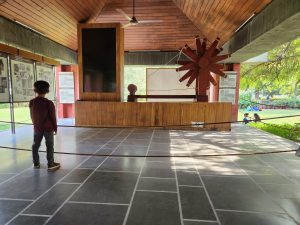
A Meeting of Great Minds and Ideals
Santiniketan, Sabarmati Ashram, and Sevagram are more than just places; they are historical landmarks that reflect the vision and ideals of two of India’s greatest leaders—Rabindranath Tagore and Mahatma Gandhi. These institutions, though rooted in different philosophies and contexts, share common threads of service, education, and the pursuit of a better society. This article explores the connections and contrasts between these iconic sites, highlighting how Tagore’s experiments in education influenced Gandhi’s work at Sevagram and Sabarmati Ashram.
Santiniketan: Tagore’s Vision of Learning and Cultural Integration
Founded by Rabindranath Tagore in the early 20th century, Santiniketan was conceived as a revolutionary educational experiment that blended traditional Indian learning with modern ideas. Tagore’s approach was deeply rooted in the philosophy of learning through nature, crafts, and arts, which aimed to foster creativity and cultural integration. Later, the adjacent Sriniketan focused on rural reconstruction, emphasizing self-reliance and community service.
Tagore’s emphasis on education through crafts and a holistic approach to learning profoundly impacted Mahatma Gandhi, who saw the potential of such methods in his own educational experiments. Notably, the first teachers at Gandhi’s basic school in Sevagram were from Santiniketan, illustrating the deep connection between the two leaders’ philosophies.
Sevagram: Gandhi’s Village of Service and a Hub of National Decision-Making
Sevagram, meaning “village of service,” was established by Mahatma Gandhi in 1936 near Wardha, Maharashtra, at the invitation of industrialist Jamnalal Bajaj. Originally intended as a simple residence for Gandhi and his wife Kasturba, Sevagram quickly became a focal point for India’s freedom movement. From 1936 to 1948, Gandhi made Sevagram his home and operational center, using it as a base to spread his message of non-violence and self-sufficiency.
Sevagram’s significance extended beyond personal philosophy; it was here that many critical decisions regarding India’s struggle for independence were made. The ashram’s ethos of service and simplicity drew many followers, turning it into a vibrant community dedicated to the ideals of Satyagraha, self-reliance, and rural development. The influence of Tagore’s educational methods was evident in Gandhi’s emphasis on learning through practical work and community service.
Sabarmati Ashram: The Cradle of India’s Non-Violent Struggle
Located on the tranquil banks of the Sabarmati River in Ahmedabad, Sabarmati Ashram was established by Gandhi in 1917 as a retreat for him and his followers. Originally founded as the Satyagraha Ashram in 1915 in Kochrab, it was later moved to Sabarmati and became a crucible for the Indian independence movement. Gandhi and his followers, known as ashramites, led a communal life here, focusing on the principles of truth, non-violence, and simple living.
Sabarmati Ashram was more than just Gandhi’s home; it was the launchpad for some of the most pivotal moments in India’s struggle for freedom, including the famous Dandi March of 1930. The ashram was disbanded in 1933, but its legacy continues to inspire those dedicated to social change and the pursuit of truth.
Comparative Analysis: Shared Ideals and Distinct Paths
While Santiniketan, Sabarmati Ashram, and Sevagram were shaped by the distinct visions of Tagore and Gandhi, they shared several foundational principles. All three institutions prioritized community living, self-reliance, and education as tools for societal transformation. Tagore’s Santiniketan emphasized education through arts, nature, and cultural synthesis, influencing Gandhi’s approach to education and community at Sevagram.
However, there were also key differences. Santiniketan’s primary focus was on creating a new kind of educational institution that broke free from colonial models, fostering creativity and internationalism. In contrast, Sevagram and Sabarmati Ashram were more centered on active participation in the freedom movement, promoting non-violent resistance, self-sufficiency, and grassroots activism.
Pillars of India’s Cultural and Political Renaissance
Santiniketan, Sabarmati Ashram, and Sevagram stand as enduring symbols of India’s cultural and political renaissance. Each institution, in its own way, contributed to the shaping of modern India, embodying the values and ideals of two of the country’s most revered figures. While Santiniketan continues to thrive as a center of learning and cultural exchange, Sevagram and Sabarmati remain beacons of Gandhi’s philosophy of service, truth, and non-violence.
Together, these places remind us of the power of vision, dedication, and the relentless pursuit of a better society. They are not just historical landmarks; they are living legacies that continue to inspire and guide the journey towards a more just and harmonious world.
Santiniketan Compared to Kalakshetra and Nrityagram: Bridging Tradition, Art, and Education

Santiniketan’s Influence on India’s Artistic Institutions
Santiniketan, founded by Rabindranath Tagore, has long stood as a beacon of progressive education, cultural synthesis, and artistic excellence in India. Its emphasis on integrating art, nature, and holistic education has inspired numerous institutions across the country, including Kalakshetra in Chennai and Nrityagram near Bengaluru. These institutions, although distinct in their approach and focus, share a common thread with Santiniketan: a commitment to nurturing the arts and fostering a deeper connection between education and cultural heritage.
Kalakshetra: A South Indian Hub of Dance and Cultural Learning
In 1936, Rukmini Devi Arundale established Kalakshetra near Madras (now Chennai) in South India. Rooted in the principles of the Theosophical Society, Kalakshetra was the first dance institute in India to develop a comprehensive theoretical syllabus for dancers. The institution not only focuses on fine arts education but also integrates a craft education research center and a school where students combine fine arts studies with primary and secondary education. This approach reflects the holistic educational model that Tagore championed at Santiniketan.
Much like Santiniketan’s open-air classes that promote a deep appreciation for nature, Kalakshetra conducts outdoor sessions, creating an environment where students can engage with art in its most natural and inspiring form. Both institutions share a belief in education that goes beyond traditional classroom settings, encouraging students to learn through direct engagement with their surroundings.
Nrityagram: A Gurukul for the Modern Dancer
Established in 1990 by the renowned dancer Protima Gauri on the outskirts of Bengaluru, Nrityagram is a unique community dedicated to preserving and promoting classical Indian dance forms. Drawing inspiration from both Kalakshetra and Santiniketan, Nrityagram follows the Gurukul tradition, where students live and learn within the community, much like the residential model envisioned by Tagore.
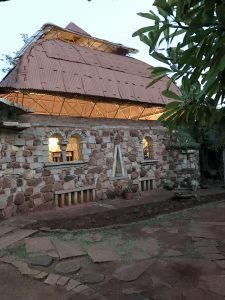
Nrityagram’s philosophy extends beyond dance education, incorporating an interdisciplinary approach that encompasses Indian literature, mythology, music, aesthetics, and spiritual thought. The community encourages students to explore the interconnectedness of various art forms and traditions, fostering a deeper understanding of their craft and the world around them. This mirrors Santiniketan’s ethos of blending art, education, and culture into a unified learning experience.
Santiniketan’s Holistic Approach: An Inspiration for Modern Arts Education
Santiniketan’s influence on institutions like Kalakshetra and Nrityagram is evident in their commitment to holistic, arts-centered education. Tagore’s vision was not just to teach art but to cultivate a way of living where creativity, learning, and community coexist harmoniously. This philosophy inspired educational models that focus on the all-round development of individuals, blending academics with artistic expression and community engagement.
While Kalakshetra emphasizes a formalized syllabus for dance and integrates arts education into primary and secondary schooling, Santiniketan’s approach remains broader, embracing a diverse array of disciplines including visual arts, music, and literature. Both institutions prioritize experiential learning, but Santiniketan’s broader educational scope allows for a more varied exploration of artistic and academic pursuits.
Embracing Nature and Self-Sufficiency: A Shared Ethos
All three institutions—Santiniketan, Kalakshetra, and Nrityagram—promote a close relationship with nature and self-sufficiency. Santiniketan’s open-air classrooms and connection to rural life reflect Tagore’s belief in learning within natural settings. Similarly, Nrityagram’s emphasis on self-sufficient living, sustainable practices, and a deep respect for the land echoes the values instilled at Santiniketan.
Nrityagram’s residential model also aligns with the communal living ideals of Santiniketan, where learning is a shared, continuous process. The focus on creating well-rounded individuals—artists who are not only skilled in their craft but also educated in philosophy, history, and spiritual thought—reflects the holistic vision that Tagore championed.
Outreach and Community Engagement: Santiniketan’s Ongoing Legacy
One of Santiniketan’s most enduring contributions is its commitment to community outreach and cultural exchange. This legacy is carried forward by both Kalakshetra and Nrityagram, which actively engage with local communities through workshops, educational programs, and performances. Nrityagram, in particular, conducts outreach programs for villages and schools, encouraging children from diverse backgrounds to explore the world of dance—a direct reflection of Tagore’s belief in accessible and inclusive education.
Santiniketan’s Lasting Influence on Indian Arts Institutions
Santiniketan, Kalakshetra, and Nrityagram, though distinct in their origins and focuses, are united by their dedication to integrating education, arts, and community. Santiniketan’s pioneering approach to holistic learning and cultural synthesis has left an indelible mark on these institutions, influencing how they shape and nurture artistic talent.
Through their shared commitment to experiential learning, self-sufficiency, and community engagement, these institutions continue to uphold the ideals that Tagore set forth, creating spaces where education and art meet to inspire future generations.
Santiniketan Compared to The Dartington Hall Trust: Two Visionary Experiments in Education and Community

The Dartington Hall Trust: A Vision Inspired by Santiniketan
Founded in 1925, The Dartington Hall Trust began when Leonard Elmhirst, an agricultural economist, and his wife, Dorothy Whitney Elmhirst, purchased a thousand-acre estate in Devon, England. The Elmhirsts were deeply influenced by Tagore’s work at Santiniketan and Sriniketan, drawing on his ideals to create a rural experiment that combined innovative farming and forestry techniques, the promotion of arts and crafts, and the establishment of educational institutions.
The Trust was conceived as a living laboratory where creativity, hands-on learning, and social justice were not just encouraged but integrated into the fabric of everyday life. Dartington’s emphasis on combining practical skills with artistic expression reflected the holistic educational approach championed by Tagore at Santiniketan, where the arts were seen as vital to personal and community development.
Educational Philosophy: Santiniketan’s Lasting Influence
Tagore’s vision for Santiniketan was not just about conventional education but about creating a space where learning through art, nature, and craft was central to the human experience. This holistic approach was mirrored in The Dartington Hall Trust’s philosophy. Dartington’s co-educational boarding school and later the Dartington College of Arts embraced Tagore’s ideals of experiential learning, creativity, and a deep connection with the natural environment.
Both Santiniketan and Dartington emphasized the importance of a learning environment that goes beyond textbooks and classrooms. Santiniketan’s open-air classes, artistic activities, and integration of nature into education are paralleled by Dartington’s commitment to nurturing creativity through arts, crafts, and environmental stewardship.
Community and Social Justice: Shared Values in Action
One of the defining characteristics of both Santiniketan and The Dartington Hall Trust is their commitment to community development and social justice. At Santiniketan, Tagore’s Sriniketan project focused on rural reconstruction, empowering local communities through education, healthcare, and sustainable agricultural practices. Similarly, Dartington was not just an estate but a social experiment that combined agricultural innovation with social reform, aiming to improve the quality of life for the surrounding communities.
Dartington’s focus on sustainability and social justice resonates with Tagore’s belief in the interdependence of society, nature, and education. Both institutions sought to bridge gaps—whether between policy and practice, rural and urban life, or art and industry—and to create models that could be replicated elsewhere to foster a more just and equitable society.
Arts and Creativity: Central Pillars of Both Institutions
For both Santiniketan and The Dartington Hall Trust, the arts were not just extracurricular activities but central pillars of their respective philosophies. Tagore’s integration of music, dance, painting, and literature into the daily life of Santiniketan was revolutionary for its time, promoting a sense of freedom and creative exploration.
The Dartington Hall Trust carried this forward by prioritizing the arts as essential to human development. With institutions like the Dartington College of Arts, the Trust became a haven for artists, musicians, and creative thinkers, fostering an environment where creativity could thrive alongside academic pursuits. Both places emphasize that the arts nourish the human spirit, enhancing personal growth and community well-being.
Sustainability and Enterprise: A Commitment to a Better Future
Sustainability is another key area where Santiniketan and Dartington’s values align. At Santiniketan, Tagore’s emphasis on living harmoniously with nature and practicing sustainable agriculture was reflected in Sriniketan’s work with local farmers. Dartington, with its focus on environmental conservation balanced with economic development, continues to champion these principles today.
The Trust’s enterprise initiatives aim to generate commercial success to fund its charitable activities, highlighting a practical approach to sustainability that supports both people and the planet. This blend of social enterprise and environmental stewardship echoes Tagore’s ideals, demonstrating that economic viability and ethical living can coexist.
Celebrating the Cultural Legacy of Santiniketan
Santiniketan stands as a unique cultural landmark that goes beyond the confines of a traditional educational institution. Founded by Rabindranath Tagore, this vibrant community has grown into a living testament to the ideals of creativity, inclusivity, and holistic learning. It is a place where art, nature, and education seamlessly intertwine, nurturing minds and souls alike.
From the open-air classrooms of Visva Bharati University to the artistic expressions seen in dance, music, and fine arts, Santiniketan embodies a spirit of cultural synthesis and innovation. It has been a melting pot of global influences, yet it remains deeply rooted in the rich traditions of India. The town’s commitment to sustainability, community engagement, and rural development reflects Tagore’s vision of a harmonious society where education goes hand in hand with service to humanity.
As a beacon of artistic and intellectual freedom, Santiniketan continues to inspire generations of students, artists, scholars, and visitors from around the world. It is more than just a place; it is a living, breathing legacy that celebrates the human spirit in all its diversity. In Santiniketan, culture is not confined to the classroom or stage—it is a way of life that invites everyone to participate, learn, and grow.

